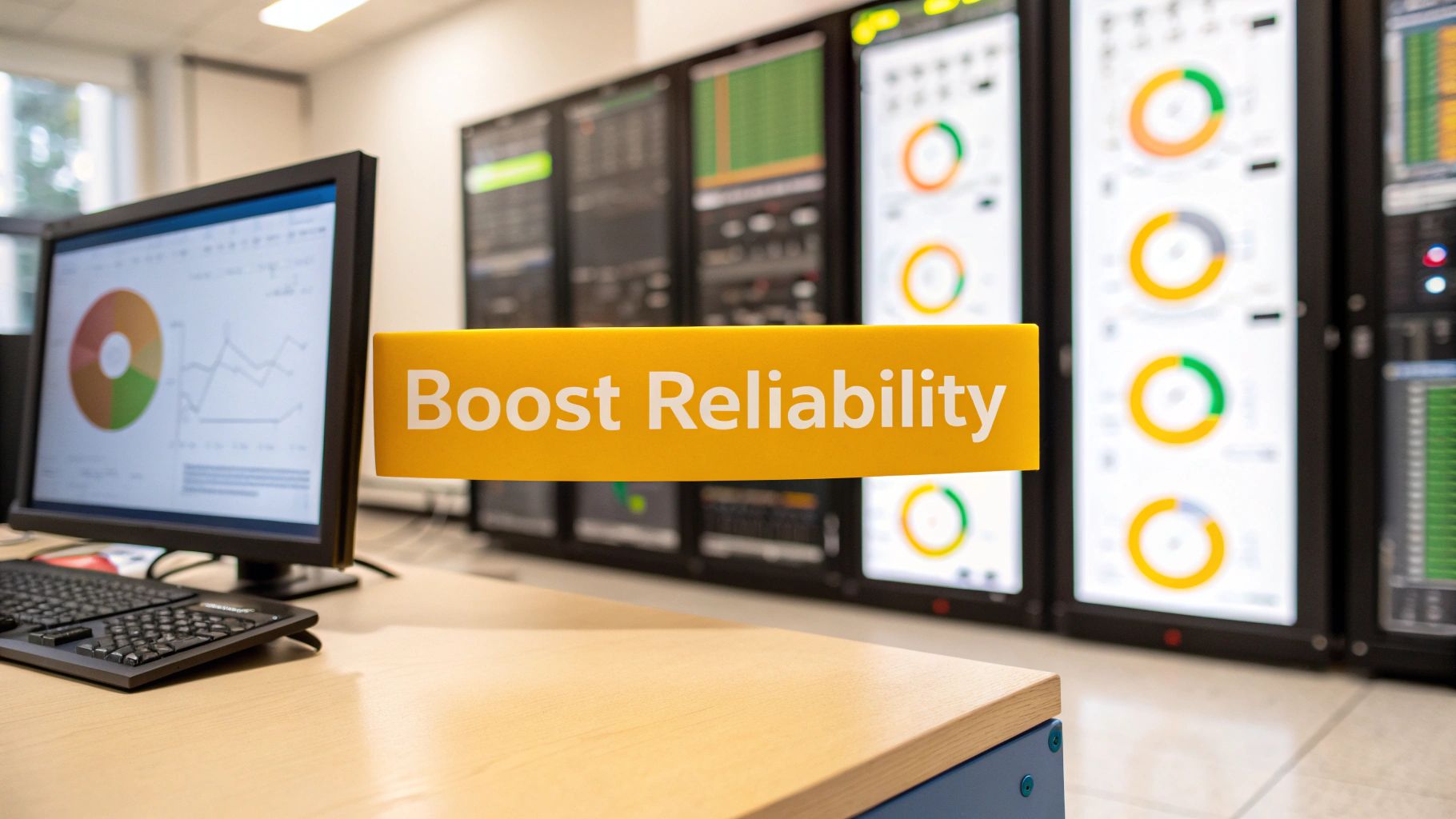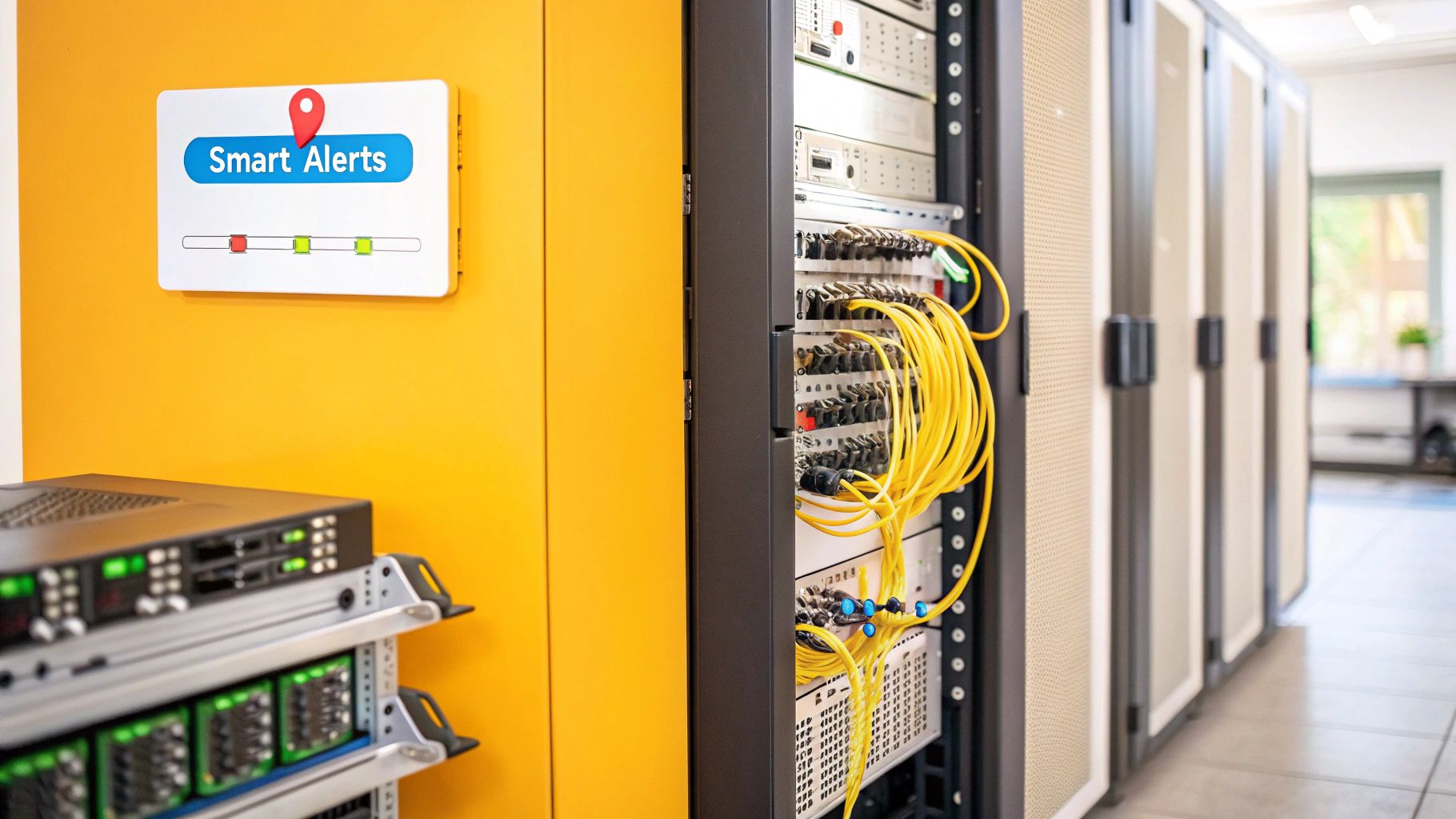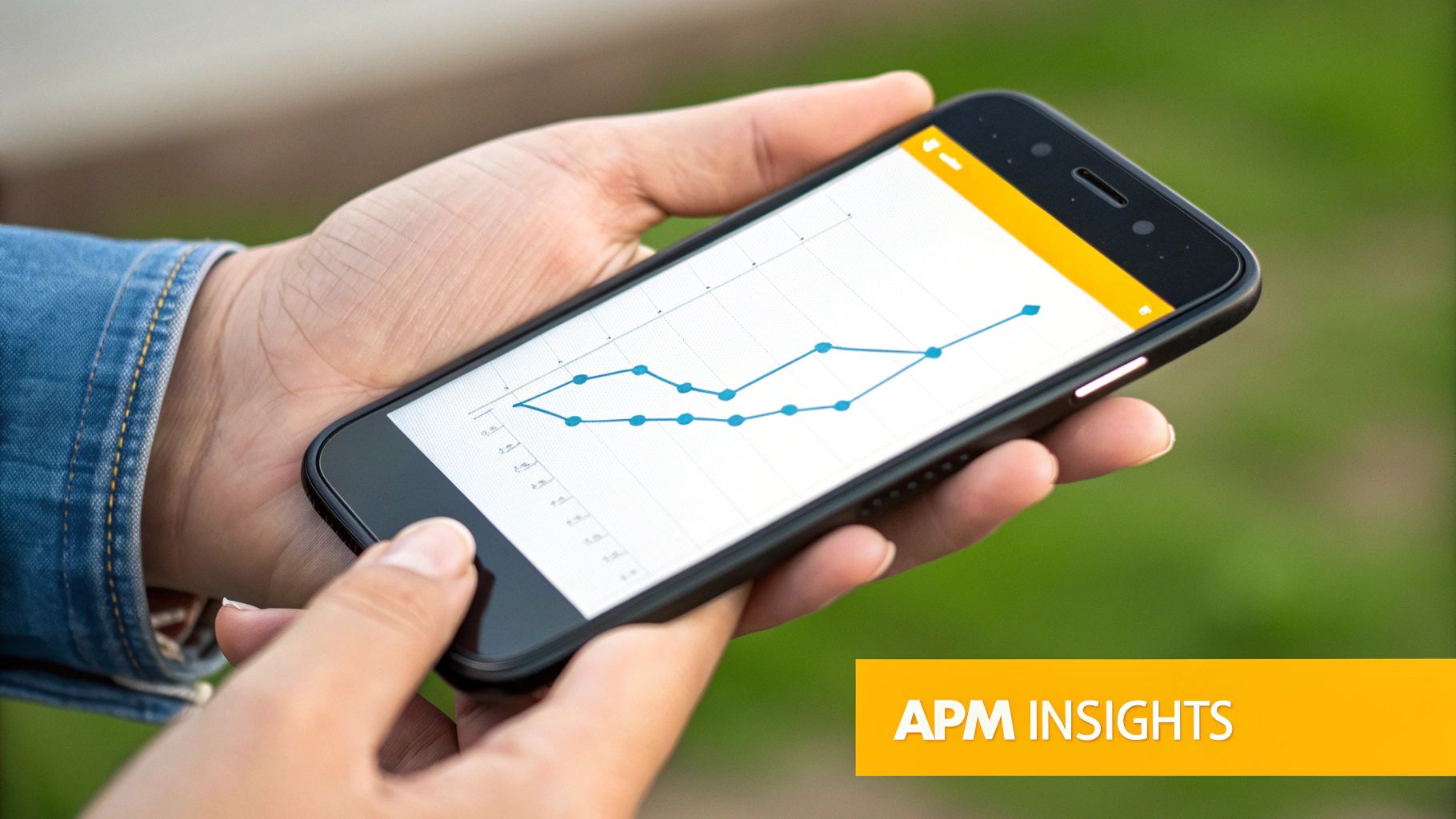Top Application Monitoring Best Practices to Boost Reliability

In today's complex digital environment, simply knowing if your application is "up" or "down" is no longer enough. High-performing engineering teams are moving beyond reactive fixes to proactive performance optimization, leveraging a sophisticated approach to observability. Effective application monitoring is the cornerstone of reliability, user satisfaction, and ultimately, business success. It is the crucial difference between discovering a critical bug from an angry customer tweet and resolving an anomaly before it ever impacts a single user.
This guide cuts through the noise to provide a detailed, actionable roundup of the most critical application monitoring best practices you need to implement. We move past generic advice to deliver specific strategies that product managers, CTOs, and development teams can use immediately to build more resilient, performant, and reliable systems. From defining and monitoring meaningful Service Level Objectives (SLOs) that directly correlate with user happiness to implementing distributed tracing for complex microservices architectures, this roundup covers the essential components of a mature monitoring strategy.
You will learn how to:
- Implement comprehensive observability with the three pillars: logs, metrics, and traces.
- Establish intelligent alerting that reduces noise and prevents alert fatigue.
- Integrate continuous monitoring directly into your CI/CD pipelines for early feedback.
- Create meaningful dashboards that provide actionable insights, not just data dumps.
Each practice detailed here is a crucial building block for any organization, from startups to large enterprises, aiming to meet the high-performance demands of modern, scalable applications.
1. Implement Comprehensive Observability with the Three Pillars
Effective application monitoring goes beyond simply tracking if a service is up or down. A fundamental best practice is to implement comprehensive observability, which allows you to understand the internal state of your system by examining its external outputs. This modern approach is built upon what are known as the three pillars: metrics, logs, and traces. Together, they provide the complete context needed to not only identify problems but to deeply understand their root cause.

This holistic strategy, popularized by tech giants and advocated by industry leaders like Charity Majors and the Cloud Native Computing Foundation (CNCF), is essential for managing complex, distributed systems. Where traditional monitoring might tell you that an error occurred, observability tells you why it happened.
Understanding the Three Pillars
Each pillar provides a unique perspective on your application's health and performance. They are most powerful when used in concert.
- Metrics: These are quantifiable measurements aggregated over time. Metrics are ideal for dashboards and alerting, providing a high-level overview of system health. Think of CPU utilization, memory usage, request rates, and error counts.
- Logs: These are immutable, time-stamped records of discrete events. Logs offer granular, detailed context about a specific event, such as a single user request or a critical error, providing the "what" and "when" for an incident.
- Traces: A trace represents the entire journey of a single request as it travels through multiple services in a distributed architecture. Traces are crucial for pinpointing bottlenecks and understanding the flow of operations across microservices.
Actionable Implementation Tips
To effectively adopt observability, start with a strategic approach that integrates all three pillars.
- Standardize Data with Correlation IDs: Implement a unique ID (a
trace_idorcorrelation_id) that is passed with a request through every service. Ensure this ID is present in your metrics, logs, and traces. This allows you to pivot seamlessly from a high-level metric spike to the specific logs and traces that caused it. - Use Structured Logging: Instead of plain text logs, use a structured format like JSON. This makes logs machine-readable, allowing for powerful querying, filtering, and analysis in your logging platform. You can search for all logs with a specific user ID or error code far more efficiently.
- Start with the "Golden Signals": As defined by Google's SRE principles, focus your initial metrics on four key areas: Latency (request time), Traffic (demand), Errors (rate of failures), and Saturation (how "full" your service is). These provide a robust foundation for understanding service health.
- Implement Smart Trace Sampling: Capturing a trace for every single request can be prohibitively expensive and generate massive data volumes. Implement a sampling strategy, such as head-based or tail-based sampling, to capture a representative subset of transactions while ensuring you always capture traces for failed or high-latency requests. This balances visibility with cost.
2. Define and Monitor Service Level Objectives (SLOs)
Beyond simple alerts, a mature application monitoring best practice is to frame reliability in terms of user happiness. Service Level Objectives (SLOs) are specific, measurable targets for performance and availability that directly reflect the user's experience. An SLO defines the threshold between acceptable and unacceptable service behavior, moving the conversation from "is the server down?" to "are users having a good experience?"

This approach, pioneered and popularized by Google's Site Reliability Engineering (SRE) teams, provides a clear, data-driven framework for balancing innovation with stability. SLOs are built on Service Level Indicators (SLIs), the direct measurements of service performance (like latency or error rate), and they dictate your "error budget"-the amount of acceptable downtime or degraded performance.
Understanding SLOs and Error Budgets
SLOs create a shared understanding of reliability goals across product, engineering, and business teams. They are not aspirational goals of 100% perfection.
- Service Level Indicator (SLI): The actual measurement. For example, the percentage of HTTP requests that complete successfully in under 300ms.
- Service Level Objective (SLO): The target for that SLI over a time window. For example, 99.9% of requests will complete successfully in under 300ms over a 30-day period.
- Error Budget: The inverse of the SLO (100% - 99.9% = 0.1%). This is the explicit, pre-approved "budget" for unreliability. If you stay within this budget, you can continue to release new features. If you burn through it, the focus must shift to reliability improvements.
Actionable Implementation Tips
To get started with SLOs, focus on what matters most to your users and integrate the process into your team's workflow.
- Start with Critical User Journeys: Begin by defining 2-3 SLOs for the most critical user-facing paths. For an e-commerce site, this might be checkout success rate or product page load time. For Slack, it's message delivery latency.
- Define SLIs as Ratios: Frame your SLIs as a ratio of good events to total valid events (e.g., successful requests / total requests). This makes them easy to understand and measure, providing a clear percentage between 0 and 100.
- Use Rolling Time Windows: Implement SLOs over a 28-day or 30-day rolling window. This provides a more stable, long-term view of reliability and prevents overreactions to short-term blips or single-day outages.
- Make Error Budgets Actionable: The real power of SLOs comes from the error budget. If the budget is spent, it should trigger a pre-agreed action, such as freezing non-essential feature releases to focus exclusively on reliability and bug fixes until the service is stable again.
3. Establish Intelligent Alerting with Reduced Noise
An avalanche of meaningless alerts is one of the fastest ways to undermine an otherwise solid monitoring strategy. A critical best practice is to establish intelligent alerting, a system designed to notify teams only about issues that are actionable and genuinely require human intervention. This approach moves beyond simple static thresholds to create a low-noise, high-signal environment that prevents alert fatigue and keeps engineers focused on what matters: real user impact.

This philosophy, heavily promoted by incident management platforms like PagerDuty and foundational to Google's SRE principles, combats the "crying wolf" syndrome. When every alert is meaningful, response times improve, and teams trust the monitoring system. Instead of reacting to minor fluctuations, engineers respond to verified, context-rich notifications that point directly to a problem affecting service quality.
Key Principles of Intelligent Alerting
Building an effective alerting system involves focusing on impact and actionability rather than raw metrics. The goal is to make every notification count.
- Alert on Symptoms, Not Causes: A core tenet is to alert on user-facing symptoms (e.g., increased error rates, high latency) instead of internal causes (e.g., high CPU utilization). High CPU is not a problem unless it actually degrades the user experience.
- Actionable Notifications: Every single alert must be tied to a specific action an engineer needs to take. If the response is "do nothing" or "just watch it," the alert is noise and should be re-evaluated or removed.
- Tiered Urgency: Not all issues are created equal. Implement a tiered system: a page or phone call for critical, SLO-breaching events; an email or Slack message for warnings that need attention soon; and dashboards for informational trends.
Actionable Implementation Tips
Transitioning from a noisy to an intelligent alerting system requires deliberate effort and continuous refinement.
- Implement Alert Correlation and Aggregation: Use tools that can group related alerts into a single, comprehensive incident. For example, if a database failure triggers 50 different downstream alerts, your system should consolidate them into one notification titled "Database Unresponsive," providing clear context.
- Include Runbooks and Context: Every alert notification should include a direct link to a runbook or wiki page explaining how to diagnose and resolve the issue. Also include relevant graphs and data points to reduce the time spent on initial investigation.
- Use Dynamic or Adaptive Thresholds: For services with natural traffic fluctuations, static thresholds create false positives. Use anomaly detection or thresholds based on a percentage change from a moving average (e.g., "alert if traffic drops 50% from the previous hour's average") to adapt to normal business cycles.
- Schedule Regular Alert Reviews: Set up a recurring meeting (e.g., bi-weekly) to review recent alerts. Analyze false positives, identify noisy alerts, and tune the rules. This feedback loop is essential for maintaining a healthy and reliable application monitoring and alerting culture.
4. Implement Application Performance Monitoring (APM) with End-User Monitoring
While observability gives you a deep view of your system's internal state, Application Performance Monitoring (APM) provides a focused lens on your application's code-level behavior and its direct impact on the end-user. This essential practice involves instrumenting your application to track transactions, code execution, and dependencies in real-time. By combining server-side APM with End-User Monitoring (EUM), which includes Real User Monitoring (RUM) and Synthetic Monitoring, you create a complete picture of application health from the backend code to the user's browser.

This powerful combination, pioneered by platforms like New Relic and Dynatrace, shifts the focus from simple system health to the actual user experience. It's the difference between knowing a database is slow and knowing exactly how that slow query impacts page load time for users in a specific region. Companies like Amazon have famously tied milliseconds of latency directly to sales, demonstrating the critical business value of this approach.
Understanding APM and End-User Monitoring
These components work together to connect backend performance with frontend experience, closing the gap between code and customer.
- Application Performance Monitoring (APM): Provides deep, code-level visibility into your application. It traces individual transactions through your services, identifying slow database queries, inefficient code paths, and external service call bottlenecks.
- Real User Monitoring (RUM): Captures performance and error data from actual user sessions in their browsers. RUM tells you how your application is performing for real people on different devices, networks, and geographic locations.
- Synthetic Monitoring: Involves deploying automated scripts to simulate user journeys for critical workflows, like login or checkout. This allows you to proactively detect issues from various global locations, even during low-traffic periods.
Actionable Implementation Tips
To effectively leverage APM and EUM, focus on correlating backend data with user-centric outcomes.
- Start with Auto-Instrumentation: Modern APM tools offer automatic instrumentation that provides significant visibility with minimal setup. Use this as your foundation, then add custom instrumentation to monitor specific business-critical transactions.
- Focus on Core Web Vitals: When analyzing RUM data, prioritize key user experience metrics like Largest Contentful Paint (LCP), First Input Delay (FID), and Cumulative Layout Shift (CLS). These directly impact user perception and SEO rankings. For more insights, you can learn more about how to improve app performance on getnerdify.com.
- Monitor Critical User Flows Synthetically: Set up synthetic tests for your most important user paths, such as completing a purchase or submitting a form. Run these tests from multiple geographic locations to ensure a consistent global experience and receive alerts before users are impacted.
- Track Apdex Scores: Use the Application Performance Index (Apdex) as a high-level metric to measure overall user satisfaction. It simplifies complex performance data into a single score representing whether users are "satisfied," "tolerating," or "frustrated."
- Correlate APM with Business Metrics: The ultimate goal is to connect performance to business outcomes. Integrate APM data with analytics to see how improvements in load time or reductions in error rates affect key metrics like conversion rates, user engagement, and revenue.
5. Adopt Infrastructure as Code (IaC) for Monitoring Configuration
Manually configuring dashboards, alerts, and checks is a brittle and unscalable process. A modern best practice is to adopt Infrastructure as Code (IaC) for your monitoring setup, treating configurations as version-controlled, testable artifacts stored alongside your application code. This applies rigorous software engineering principles like code reviews, versioning, and automated deployment to your entire monitoring ecosystem.
This strategy, championed by organizations like HashiCorp and Spotify, transforms monitoring from a manual, error-prone task into a repeatable and automated process. By codifying your monitoring rules, you ensure consistency across all environments (dev, staging, production), enable rapid disaster recovery, and make every change traceable and auditable through Git history.
What is Monitoring as Code?
Monitoring as Code means defining your entire monitoring apparatus declaratively in configuration files rather than clicking through a UI. This includes:
- Dashboards: Defining graphs, panels, and data sources in files (e.g., JSON, YAML).
- Alerting Rules: Specifying alert conditions, thresholds, and notification channels in code.
- Synthetic Checks: Scripting user journey tests and API health checks.
- Metric Collection: Configuring agents and exporters declaratively.
Actionable Implementation Tips
To effectively implement IaC for your monitoring, integrate it directly into your development lifecycle.
- Store Monitoring Code with Application Code: Place monitoring configurations (like Grafana dashboard JSON or Prometheus alert rules) in the same repository as the service they monitor. This tight coupling ensures that when a new feature or API endpoint is added, the corresponding monitoring is updated in the same pull request.
- Use Parameterized Templates: Avoid duplicating code by creating templates for common monitoring patterns. For instance, create a standard dashboard template for a microservice and use variables for service name, environment, and specific metrics. Tools like Jsonnet or Terraform modules excel at this.
- Implement a GitOps Workflow: Use a GitOps-style pipeline to automatically sync changes from your repository to your monitoring platform. When a pull request with a new alert rule is merged, a CI/CD job should automatically apply it to Prometheus or your chosen tool.
- Tag and Version Configurations: Align your monitoring configuration versions with your application releases. Using Git tags, you can easily roll back monitoring to a previous state if a change introduces noise or misses a critical condition, ensuring your application monitoring best practices remain stable.
6. Implement Distributed Tracing for Microservices
In modern, distributed architectures, a single user request can trigger a complex cascade of calls across dozens or even hundreds of microservices. Understanding performance in such an environment is impossible with traditional monitoring alone. This is where distributed tracing becomes an indispensable practice, providing a complete, end-to-end view of a request's entire journey through your system. It visualizes the entire request path, showing how services interact and where time is spent.
Pioneered by systems like Google's Dapper and popularized by open-source tools like Jaeger (from Uber) and Zipkin (from Twitter), distributed tracing is now a cornerstone of observability. Where metrics show a spike in latency and logs show an error, a trace pinpoints the exact service, database call, or API interaction responsible for the problem, making it a critical tool for debugging complex systems.
Understanding the Trace Lifecycle
Distributed tracing provides a detailed, contextual narrative for every request, composed of interconnected parts.
- Trace: A trace represents the entire end-to-end journey of a single request. It is a collection of all the operations that occurred as a result of that initial request.
- Span: Each individual unit of work within a trace is called a span. For example, a single trace might contain spans for an API gateway call, a user authentication service, and a database query.
- Trace Context: This is the metadata (like a
trace_idandspan_id) that is propagated from one service to the next. This context is what links all the individual spans together into a single, cohesive trace.
Actionable Implementation Tips
To effectively leverage distributed tracing, focus on standardization and intelligent data collection.
- Adopt OpenTelemetry: Start with OpenTelemetry (OTel), a CNCF project that provides a vendor-neutral standard for instrumentation. Using OTel prevents vendor lock-in and allows you to send trace data to any compatible backend without re-instrumenting your code.
- Tag Spans with Rich Metadata: Enhance your traces by adding key-value tags (attributes) to your spans. Include contextual information like
user_id,tenant_id,environment, andapp_version. This makes your traces infinitely more searchable and useful for debugging specific user issues. - Propagate Context Everywhere: Ensure the trace context is propagated across all communication boundaries. This includes not just HTTP headers in API calls but also message attributes in event queues (like RabbitMQ or Kafka) and asynchronous jobs. If context is lost, the trace is broken. For a deeper dive into this architecture, explore these insights on ecommerce microservices architecture.
- Use Trace Exemplars: Link your metrics directly to your traces. Exemplars are references to specific trace IDs that are included with your metric data. When you see a latency spike on a dashboard, you can click to see an example trace that contributed to that spike, instantly bridging the gap between "what" happened and "why."
7. Create Meaningful Dashboards and Visualization Strategies
Raw monitoring data is only useful if it can be understood quickly. An essential application monitoring best practice is to create meaningful dashboards that transform complex data streams into actionable, at-a-glance insights. Effective visualization strategies support rapid decision-making by presenting information tailored to specific audiences and use cases, from high-level executive overviews to granular incident response views.
This approach, championed by visualization leaders like Grafana Labs and SRE pioneers at Google, moves beyond simple data dumps. Instead, it focuses on designing information hierarchies that reduce cognitive load, allowing teams to instantly assess system health, identify emerging problems, and understand the impact of events like deployments or outages.
Understanding Dashboard Types and Design
Different dashboards serve distinct purposes, and a one-size-fits-all approach is ineffective. The key is to design each dashboard for its intended audience and function.
- Executive Dashboards: Provide a high-level view of business health, focusing on key performance indicators (KPIs) like user sign-ups, revenue, and overall service availability.
- Operational Dashboards: Designed for on-call engineers and SREs for incident response. These display critical service health metrics, SLO burn rates, and error budgets, enabling quick problem diagnosis. SoundCloud's adoption of RED method dashboards (Rate, Errors, Duration) for every microservice is a prime example.
- Analytical Dashboards: Used for deep-dive investigations and long-term trend analysis. These dashboards allow engineers to explore data, correlate different metrics, and uncover the root causes of complex performance issues.
Actionable Implementation Tips
To build dashboards that inform rather than overwhelm, focus on clarity, context, and consistency. Beyond the design principles, effective dashboard creation often involves leveraging powerful data visualization tools. If you're looking to elevate your approach, you can explore data visualization tools and strategies to find platforms that best suit your needs.
- Follow the Inverted Pyramid: Place the most critical, summary-level information at the very top. Key metrics like SLO status, error budget remaining, and overall health scores should be immediately visible without scrolling.
- Standardize with Frameworks: Build dashboards around established methodologies like the RED Method (Rate, Errors, Duration) for services or the USE Method (Utilization, Saturation, Errors) for resources. This creates a consistent and predictable layout across all your services.
- Add Context with Annotations: Automatically add annotations to your charts for key events like code deployments, feature flag changes, and incidents. This makes it trivial to correlate a change in system behavior with a specific event.
- Use a Consistent Color Scheme: Implement a standard color language across all dashboards, such as green for healthy, yellow for warning, and red for critical states. This consistency allows for instant recognition of system status.
- Limit Panels for Clarity: A cluttered dashboard is an ineffective one. Aim to limit each dashboard to 5-7 key panels to ensure the most important information is easily digestible. Provide links to more detailed, secondary dashboards for deeper investigation.
8. Establish Continuous Monitoring in CI/CD Pipelines
Application monitoring should not begin after code is in production; it must be an integral part of your delivery lifecycle. A critical best practice is to establish continuous monitoring within your CI/CD pipelines, shifting performance and reliability validation left. This practice embeds automated quality and health checks directly into the deployment process, allowing teams to catch issues before they impact all users.
This "shift-left" approach transforms monitoring from a reactive, post-deployment activity into a proactive, continuous quality gate. Pioneered by companies like Netflix and Google, this methodology ensures that every release is validated against key performance indicators, enabling automated, data-driven decisions about whether to promote, hold, or roll back a deployment.
Extending Quality Gates Beyond Functional Tests
Continuous monitoring in CI/CD moves beyond simple pass/fail unit tests to assess the real-world impact of a change. It validates the non-functional requirements essential for a good user experience.
- Performance Validation: Automated tests run within the pipeline measure latency, throughput, and resource consumption to catch performance regressions before they reach production.
- Reliability Checks: Deployments are monitored for increases in error rates or system instability, providing an early warning system for potential outages.
- SLO Conformance: New releases are automatically checked against predefined Service Level Objectives (SLOs), ensuring that changes do not degrade the user experience.
Actionable Implementation Tips
To effectively integrate monitoring into your CI/CD process, focus on automation and progressive delivery strategies.
- Implement Progressive Delivery: Use deployment strategies like blue-green or canary releases. These techniques allow you to expose a new version to a small subset of users first, analyze its performance with your monitoring tools, and then decide whether to proceed with a full rollout.
- Automate Canary Analysis: Instead of manually watching dashboards, automate the comparison of key metrics (latency, error rate, CPU usage) between the new canary version and the stable baseline version. Tools can automatically promote or roll back the release based on predefined success criteria.
- Define Clear Deployment Gates: For each stage of the pipeline, define explicit, metric-based success criteria. For example, "promote to the next stage if the P95 latency of the canary is within 5% of the baseline and the error rate is below 0.1% after a 15-minute soak time."
- Use Synthetic Tests Post-Deployment: Immediately after a new version is deployed to any environment (even a staging one), trigger synthetic tests that simulate critical user journeys. This proactive check validates that key functionalities are working as expected before real users are affected. This practice aligns well with the principles of iterative improvement found in many modern development approaches. To go deeper, check out these agile software development best practices on getnerdify.com.
Best Practices Comparison of 8 Monitoring Strategies
| Practice / Aspect | Implementation Complexity 🔄 | Resource Requirements ⚡ | Expected Outcomes 📊 | Ideal Use Cases 💡 | Key Advantages ⭐ |
|---|---|---|---|---|---|
| Implement Comprehensive Observability with the Three Pillars | High – integration of metrics, logs, and traces across systems | High – extensive storage and multiple tools needed | Complete visibility, faster root cause analysis, improved MTTR | Complex distributed systems, microservices at scale | End-to-end visibility, proactive detection, dependency insights |
| Define and Monitor Service Level Objectives (SLOs) | Moderate – requires SLI identification and target setting | Moderate – tools for tracking and alerting SLO compliance | Clear reliability targets, data-driven decisions, reduced alert fatigue | Teams balancing feature velocity and reliability | Objective health criteria, error budget management, shared understanding |
| Establish Intelligent Alerting with Reduced Noise | High – setup of dynamic thresholds, correlation, ML-based tuning | High – advanced platforms and ongoing maintenance needed | Significantly reduced false positives, faster incident response | Environments needing actionable alerts with minimal noise | Reduced alert fatigue, better on-call experience, increased alert trust |
| Implement Application Performance Monitoring (APM) with End-User Monitoring | Moderate to High – requires instrumentation and integration with RUM and synthetic monitoring | High – agent deployment, data storage for detailed traces | Deep performance insights, user-centric metrics, quick regression detection | Web and mobile applications needing detailed performance monitoring | Code-level diagnosis, user experience focus, proactive optimization |
| Adopt Infrastructure as Code (IaC) for Monitoring Configuration | Moderate – requires IaC tooling knowledge and pipeline setup | Moderate – tooling for version control and automation | Consistent, reproducible monitoring configs, faster recovery | Large scale, multi-environment monitoring deployments | Consistency, collaboration via code review, automation & rollback |
| Implement Distributed Tracing for Microservices | High – cross-service instrumentation and standardization | High – trace data storage and processing infrastructure | Detailed request paths, bottleneck identification, service dependency mapping | Distributed microservices architectures requiring latency analysis | Precise bottleneck detection, debug complex flows, dependency visualization |
| Create Meaningful Dashboards and Visualization Strategies | Low to Moderate – design and maintenance focused | Low to Moderate – dashboarding tools and data sources | Faster incident understanding, improved communication | All teams needing clear insights tailored to roles | Accelerated troubleshooting, shared views, reduced cognitive load |
| Establish Continuous Monitoring in CI/CD Pipelines | Moderate – integration with pipelines and validation gates | Moderate to High – test environments and monitoring tools | Early detection of regressions, deployment confidence | Teams practicing CI/CD needing automated quality assurance | Faster deployment, objective validations, shift-left reliability |
From Data to Decisions: Cultivating a Culture of Reliability
Navigating the complex landscape of modern applications requires more than just a cursory glance at server uptime. As we've explored, true mastery comes from a deep, holistic understanding of your system's behavior, performance, and user impact. The journey from raw data to informed, strategic decisions is paved with the robust application monitoring best practices detailed throughout this guide. Adopting these principles is not merely a technical checklist; it is a fundamental cultural shift towards prioritizing reliability, fostering collaboration, and embedding quality into every stage of the development lifecycle.
The practices we've covered, from implementing the three pillars of observability (logs, metrics, and traces) to defining user-centric Service Level Objectives (SLOs), serve as the cornerstones of a proactive operational strategy. They empower your team to move beyond a reactive state of constant firefighting, where alerts signal existing disasters, to a predictive posture where potential issues are identified and mitigated long before they affect your end-users. This evolution is the hallmark of a mature engineering organization.
Key Takeaways for a Resilient Future
Let's distill the core themes into actionable pillars for your organization:
- Shift from Monitoring to Observability: Don't just collect data; ask intelligent questions of your system. Implementing distributed tracing for microservices and correlating metrics with logs provides the context needed to understand the "why" behind any performance anomaly, not just the "what."
- User-Centricity is Non-Negotiable: Your monitoring strategy must be anchored to the user experience. Defining SLOs based on what your customers value, and supplementing backend APM with Real User Monitoring (RUM), ensures your engineering efforts are directly aligned with business success and customer satisfaction.
- Automate for Consistency and Speed: Manual configuration is a recipe for errors and operational drag. By adopting Infrastructure as Code (IaC) for your monitoring setup and integrating continuous monitoring into your CI/CD pipelines, you create a system that is repeatable, scalable, and self-documenting. This automation is crucial for maintaining velocity without sacrificing stability.
- Signal Over Noise: An avalanche of low-context alerts leads to alert fatigue and burnout. The goal is intelligent alerting that is actionable, context-rich, and tied directly to SLO violations. This transforms your on-call engineers from beleaguered system janitors into strategic first responders.
Your Next Steps: Putting Best Practices into Action
Embarking on this journey can feel daunting, but progress is iterative. Start by selecting one or two high-impact areas to focus on.
- Conduct a Monitoring Audit: Assess your current tools and practices against the best practices outlined here. Where are the biggest gaps? Are you blind to user experience issues? Is your team drowning in noisy alerts?
- Define Your First SLOs: Pick a critical user journey and work collaboratively with product and business stakeholders to define meaningful SLOs. This single exercise can radically reframe how your team thinks about performance and reliability.
- Create a Centralized Dashboard: Build a "single pane of glass" dashboard that visualizes the health of a key service, incorporating metrics, SLO status, and business KPIs. Make it visible to everyone, fostering a shared sense of ownership.
Implementing these advanced application monitoring best practices is a powerful investment in your product's future and your team's sanity. It builds a virtuous cycle where rich, contextual data provides actionable insights, which in turn fuel smarter development, more resilient infrastructure, and ultimately, a superior and more reliable user experience. This transformation elevates monitoring from a simple operational utility into a core strategic advantage that drives business growth. The path to a truly observable and resilient system is a continuous journey, but it is one that pays dividends at every step.